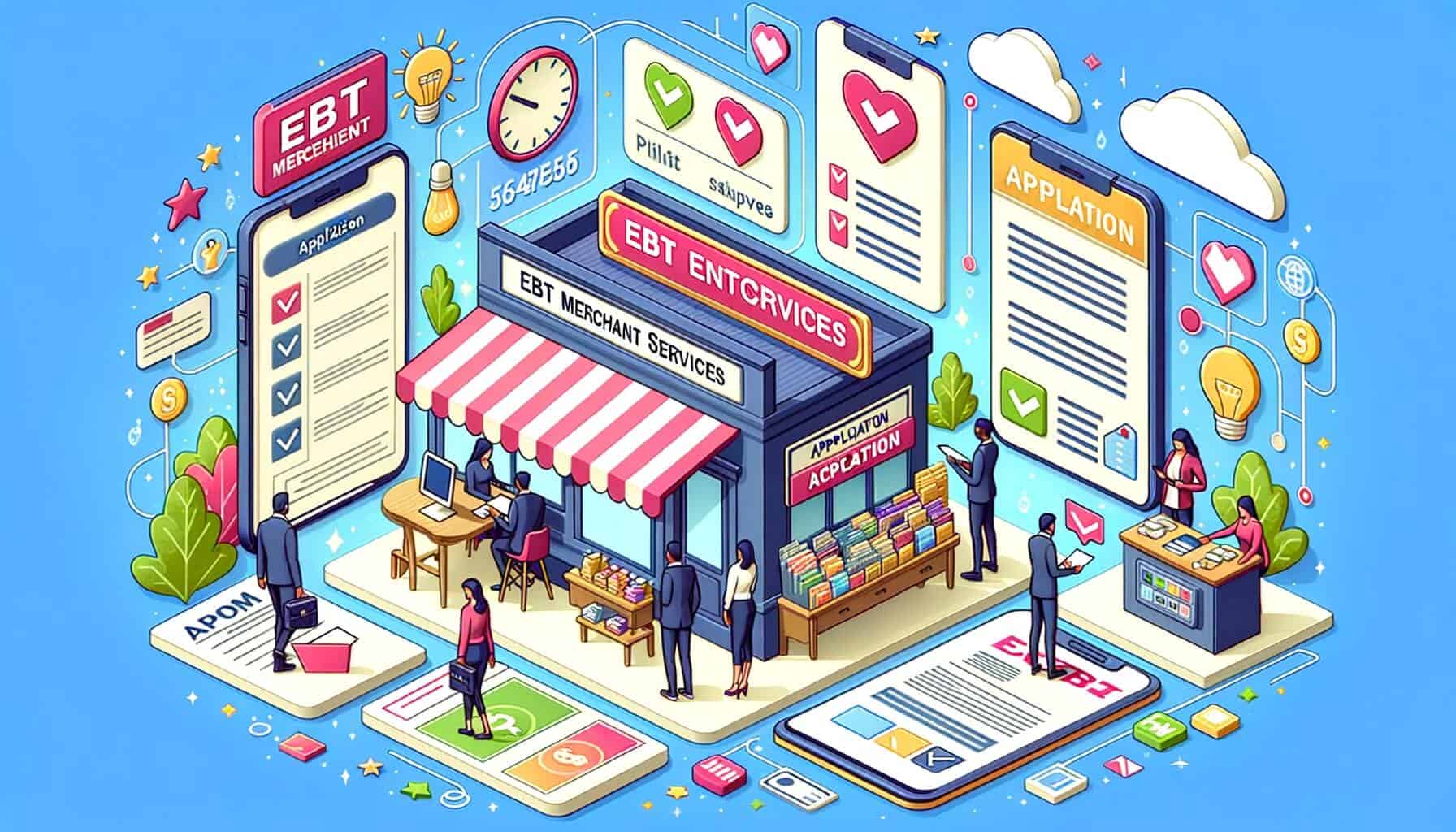
By Sharon Watson April 9, 2025
In today’s digital age, accepting electronic payments has become a necessity for businesses of all sizes. One such payment method that has gained popularity is the Electronic Benefit Transfer (EBT) system. EBT allows eligible individuals to access government benefits, such as Supplemental Nutrition Assistance Program (SNAP) benefits, through a card similar to a debit or credit card.
As a merchant, accepting EBT payments can open up a new customer base and increase your sales. In this article, we will guide you through the process of applying for EBT merchant services for your store.
Understanding the Benefits of Accepting EBT Payments

Before diving into the application process, it is essential to understand the benefits of accepting EBT payments. By accepting EBT, you can tap into a significant market segment that relies on government assistance for their daily needs. According to the United States Department of Agriculture (USDA), over 42 million Americans received SNAP benefits in 2020. By accepting EBT, you can attract these customers to your store and increase your revenue.
Accepting EBT payments also provides a convenient and secure payment option for your customers. EBT cards work similarly to debit cards, allowing users to make purchases without the need for cash. This convenience can lead to increased customer satisfaction and loyalty.
Eligibility Requirements for EBT Merchant Services

To apply for EBT merchant services, you must meet certain eligibility requirements. These requirements ensure that only legitimate businesses can participate in the program. The specific eligibility criteria may vary depending on your location, but some common requirements include:
1. Business Type: Typically, only retailers that sell eligible food items can apply for EBT merchant services. This includes grocery stores, supermarkets, farmers markets, and convenience stores. Non-food retailers, such as clothing stores or electronics shops, are generally not eligible.
2. Licensing and Permits: You must have all the necessary licenses and permits required to operate your business legally. This includes a valid business license, sales tax permit, and any other permits specific to your industry.
3. Compliance with SNAP Regulations: If you plan to accept SNAP benefits, you must comply with the regulations set by the USDA’s Food and Nutrition Service (FNS). These regulations include stocking a certain percentage of staple food items and maintaining accurate records of SNAP transactions.
Step-by-Step Guide to Applying for EBT Merchant Services
Now that you understand the benefits and eligibility requirements, let’s dive into the step-by-step guide to applying for EBT merchant services.
1. Research EBT Programs: Start by researching the EBT programs available in your state or region. Each program may have its own set of rules and application processes. Contact your state’s EBT program office or visit their website to gather information about the application process.
2. Determine Program Participation: Decide which EBT programs you want to participate in. In addition to SNAP, there may be other programs like Women, Infants, and Children (WIC) or Temporary Assistance for Needy Families (TANF) that you can choose to accept.
3. Contact EBT Provider: Reach out to the EBT provider in your state to obtain an application package. The provider will guide you through the application process and provide you with the necessary forms and instructions.
4. Gather the Necessary Documentation: Before filling out the application form, gather all the required documentation. This may include your business license, sales tax permit, proof of compliance with SNAP regulations, and financial statements.
5. Complete the Application Form: Carefully fill out the application form, providing accurate and detailed information about your business. Be prepared to answer questions about your store’s location, hours of operation, and the types of products you sell.
6. Review and Submit the Application: Review the completed application form to ensure all information is accurate and complete. Attach the required documentation and submit the application to the EBT provider as instructed.
7. Wait for Approval: After submitting your application, you will need to wait for the EBT provider to review and process it. The approval process may take several weeks, so be patient during this time.
8. Attend Training (if required): Depending on your state’s requirements, you may need to attend training sessions to learn how to properly process EBT transactions. These sessions will familiarize you with the EBT system and ensure compliance with program regulations.
9. Obtain Equipment and Software: Once your application is approved, you will need to obtain the necessary equipment and software to accept EBT payments. This may include a point-of-sale (POS) system or a card reader specifically designed for EBT transactions.
10. Test and Implement: Before officially accepting EBT payments, test your equipment and software to ensure everything is functioning correctly. Train your staff on how to process EBT transactions and implement the necessary procedures in your store.
Gathering the Necessary Documentation for Your Application

When applying for EBT merchant services, you will need to gather specific documentation to support your application. The required documents may vary depending on your state or region, but here are some common documents you may need:
1. Business License: Provide a copy of your valid business license or permit.
2. Sales Tax Permit: Include a copy of your sales tax permit or certificate.
3. Proof of Compliance with SNAP Regulations: If you plan to accept SNAP benefits, provide documentation that proves your compliance with SNAP regulations. This may include inventory records, purchase invoices, or other relevant documents.
4. Financial Statements: Some states may require you to submit financial statements, such as profit and loss statements or balance sheets, to demonstrate your business’s financial stability.
5. Identification Documents: You may need to provide identification documents, such as a driver’s license or passport, to verify your identity as the business owner.
6. Store Lease or Ownership Documents: If you rent your store, provide a copy of your lease agreement. If you own the property, include proof of ownership, such as a property deed or mortgage statement.
7. Business Plan: In some cases, you may be asked to submit a business plan that outlines your store’s operations, target market, and growth strategies.
8. Employee Information: If you have employees, you may need to provide their information, such as Social Security numbers or employment contracts, as part of the application process.
Completing the EBT Merchant Services Application Form

The application form is a crucial part of the EBT merchant services application process. It requires detailed information about your business and your intentions to accept EBT payments. Here are some key sections you may find in the application form:
1. Business Information: Provide basic information about your business, such as the legal name, address, phone number, and email address. Include details about the type of business you operate, such as a grocery store or farmers market.
2. Ownership Information: Indicate whether your business is a sole proprietorship, partnership, corporation, or any other legal entity. Provide the names and contact information of all owners or partners.
3. Store Details: Describe your store’s physical location, including the square footage, number of checkout lanes, and any unique features that may impact the EBT transaction process.
4. Product Information: Specify the types of products you sell and whether they are eligible for EBT payments. This may include staple food items, non-food items, or a combination of both.
5. Hours of Operation: State your store’s regular hours of operation, including any variations for weekends or holidays.
6. SNAP Compliance: If you plan to accept SNAP benefits, answer questions related to your compliance with SNAP regulations. This may include inquiries about your inventory, pricing, and record-keeping practices.
7. Equipment and Software: Indicate the type of equipment and software you plan to use to process EBT transactions. This may include a POS system, card reader, or any other approved EBT processing device.
8. Authorized Representative: Provide the name and contact information of the person authorized to represent your business in matters related to EBT merchant services.
Submitting Your Application and Waiting for Approval
Once you have completed the application form and gathered all the necessary documentation, it’s time to submit your application to the EBT provider. Follow the instructions provided by the provider to ensure a smooth submission process. Here are some tips to keep in mind:
1. Double-Check Your Application: Before submitting your application, review it carefully to ensure all information is accurate and complete. Check for any missing documents or signatures.
2. Make Copies: Make copies of your completed application form and all supporting documents for your records. This will help you track your application and provide proof of submission if needed.
3. Submit by the Deadline: Pay attention to any deadlines specified by the EBT provider. Submit your application well before the deadline to allow ample time for processing.
4. Follow Up: After submitting your application, consider following up with the EBT provider to confirm receipt and inquire about the estimated processing time. This will help you stay informed about the status of your application.
5. Be Patient: The approval process may take several weeks, depending on the volume of applications received by the EBT provider. Be patient and avoid contacting them excessively for updates.
Setting Up Your Store to Accept EBT Payments
Once your application is approved, it’s time to set up your store to accept EBT payments. This involves obtaining the necessary equipment, training your staff, and implementing the required procedures. Here are the steps to follow:
1. Obtain EBT Processing Equipment: Contact your EBT provider or an approved vendor to obtain the necessary equipment to process EBT transactions. This may include a POS system, card reader, or other approved devices.
2. Install and Configure Equipment: Install the EBT processing equipment in your store and configure it according to the instructions provided by the EBT provider or vendor. Test the equipment to ensure it is functioning correctly.
3. Train Your Staff: Train your staff on how to process EBT transactions using the new equipment. Familiarize them with the EBT system, including how to handle EBT cards, enter transaction amounts, and provide receipts.
4. Display EBT Acceptance Signage: Place visible signage in your store to inform customers that you accept EBT payments. This will help attract EBT cardholders and increase awareness of your participation in the program.
5. Implement Record-Keeping Procedures: Develop and implement procedures to accurately record and reconcile EBT transactions. This may include maintaining separate records for EBT sales, reconciling them with your daily sales reports, and retaining transaction records for the required period.
6. Stay Updated on Program Changes: Keep yourself informed about any changes or updates to the EBT program regulations. This will help you stay compliant and avoid any penalties or issues with your EBT merchant services.
Frequently Asked Questions about EBT Merchant Services
Q1. Can any business apply for EBT merchant services?
A1. No, only eligible retailers that sell eligible food items can apply for EBT merchant services. Non-food retailers are generally not eligible.
Q2. How long does it take to get approved for EBT merchant services?
A2. The approval process can take several weeks, depending on the volume of applications received by the EBT provider. It is important to be patient during this time.
Q3. Can I accept both SNAP and other EBT programs?
A3. Yes, you can choose to accept multiple EBT programs, such as SNAP, WIC, or TANF, depending on your business’s eligibility and your customers’ needs.
Q4. What equipment do I need to accept EBT payments?
A4. You will need EBT processing equipment, such as a POS system or card reader, specifically designed for EBT transactions. Contact your EBT provider or an approved vendor to obtain the necessary equipment.
Q5. How do I train my staff to process EBT transactions?
A5. Provide training sessions to your staff on how to process EBT transactions using the new equipment. Familiarize them with the EBT system, including handling EBT cards, entering transaction amounts, and providing receipts.
Conclusion
Accepting EBT payments can be a valuable addition to your store’s payment options. By tapping into the market of individuals relying on government assistance, you can increase your customer base and revenue. However, it is crucial to understand the eligibility requirements and follow the step-by-step guide to applying for EBT merchant services.
Gathering the necessary documentation, completing the application form accurately, and submitting it to the EBT provider are essential steps in the process. Once approved, setting up your store to accept EBT payments involves obtaining the necessary equipment, training your staff, and implementing the required procedures. By following these steps, you can successfully apply for EBT merchant services and provide a convenient payment option for your customers.